From Pilot to Permanent: The Evolution of PICK Transportation in Oklahoma: 2025 Update
20 minutes Author: Shared-Use Mobility Center Date Launched/Enacted: Sep 30, 2025 Date Published: September 30, 2025
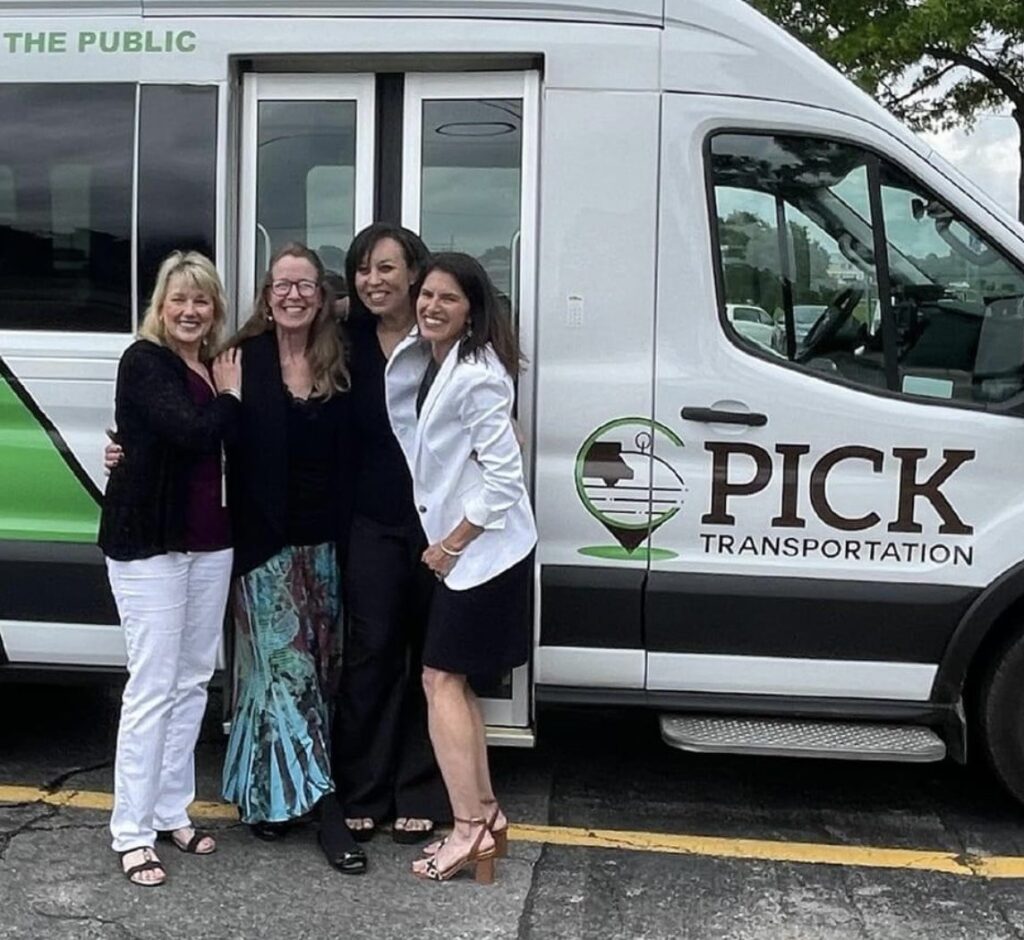
Summary
- PICK Transportation is an on-demand microtransit service that launched as a demonstration project in 2021 to serve rural and Tribal communities in eastern Oklahoma.
- PICK Transportation was developed with support from a Federal Transit Administration Integrated Mobility Innovation grant to address mobility gaps during weekday evenings and weekends when traditional fixed-route transit services are typically unavailable.
- Following its demonstration period, program leaders leveraged partnerships to secure sustainable funding and have since expanded to serve more communities across the state.
- The evolution of PICK Transportation highlights how transit agencies can be resourceful and creative in transitioning innovative, grant-funded pilot projects into a lasting and sustainable public transportation service.

This project is part of the Mobility Innovation Collaborative (MIC). The MIC provides a comprehensive suite of technical assistance resources, promotes knowledge sharing activities, and captures stories and lessons learned from innovative mobility projects across the United States.
Originally published September 2025.
Description: Video Interview with Kendra McGready and LaTischa LeMasters about PICK Transportation. Credit: Shared-Use Mobility Center (SUMC)
Introduction
PICK Transportation is an on-demand microtransit service that launched as a demonstration project in eastern Oklahoma in 2021. Since then, it has expanded to serve new regions across Oklahoma, developed strategic partnerships, and adapted to the evolving needs of riders. PICK is operated by a consortium of public and Tribal transit providers, which partners with communities, hospitals, and local organizations to offer a flexible and fully ADA-compliant transportation service that operates during weekday evening hours and Saturdays, primarily during times when fixed-route transit is typically unavailable in rural areas. The service was created to address mobility gaps for underserved riders in rural and Tribal communities and includes mobile booking and payment options to make scheduling rides more convenient.
Pelivan Transit serves as the lead agency for the PICK program and operates under the Grand Gateway Economic Development Association (GGEDA), an association of local governments and economic development entities in Northeast Oklahoma. PICK was developed and supported by a $1.5 million initial funding from the Federal Transit Administration’s (FTA) Integrated Mobility Innovation (IMI) program, awarded in 2020 to GGEDA, and has advanced from a demonstration pilot project to a sustainable, expanding, and increasingly impactful rural mobility service.
This case study builds on the 2023 Bringing Regional Mobility-On-Demand Service to Rural Oklahoma: a case study of PICK Transportation and explores how the program has evolved following the completion of the IMI grant program in June 2023.
Background
PICK Transportation began as a consortium that brought together four rural transit providers — Pelivan Transit, JAMM Transit, Cimarron Public Transit System, and KI BOIS Area Transit System (KATS) – along with nine Tribal nations to provide weeknight and weekend microtransit services to rural communities.
The idea for PICK Transportation emerged in 2019 from a rider survey conducted by Pelivan Transit and its fellow rural transit agencies, which identified a significant demand for more on-demand transportation on weeknight and weekends, particularly for individuals with non-traditional work schedules. The consortium also builds on partnerships established through the earlier Veterans Ride Connect (VRC) program, in which the same providers collaborated to offer weekday rides (6:00 a.m. to 6:00 p.m.) across 29 rural counties for veterans. Through their experience with VRC, the agencies identified overlapping service gaps and began discussing broader mobility needs in the region, including the lack of evening transportation options.
GGEDA officially launched PICK in June 2021 in the communities of Atoka, Bartlesville, Owasso, and Tahlequah. The Oklahoma Department of Transportation (ODOT) supported GGEDA’s IMI grant award by providing a significant portion of the local match required for the grant, which provided funding throughout the demonstration project.
PICK’s participant agencies were initially designed to meet the transportation needs of people commuting to work, especially those employed at local casinos. However, during the demonstration period, the agencies discovered through the analysis of ridership and destinations data a range of other unmet mobility needs within the community. This prompted a broader rethinking of rural transit delivery and highlighted the utility of adaptable, demand-responsive transportation solutions in rural areas beyond traditional transit modes. As a result, PICK evolved from a primarily workforce-focused service to serve a wider spectrum of transportation needs within the community. This included trips for childcare, food access, after-hours dialysis, and hospital discharges— services that are often difficult or impossible to secure through traditional transit options in rural areas. In responding to these varied and essential travel needs, PICK underwent a significant transformation in the range of services offered and in their approach to service. PICK’s transformation allowed it to better support a broader range of trip purposes, proving that innovative transit can adapt efficiently as riders’ needs change.
The partnerships formed by the consortium have been instrumental in supporting its program through various levels of responsibility and financial contribution. Since PICK operates as a consortium, cultivating partnerships and collaboration among its members is key to aligned and coordinated operations. The consortium operating PICK developed memorandums of understanding (MOUs) and documentation detailing standard operating procedures to provide clarity to partner transportation providers on their role in the consortium. The partners of PICK operate services in designated zones within their respective communities and collaborate to deliver a coordinated transportation service.
During the IMI grant period, news of the services’ impact sparked an interest from surrounding rural communities, prompting many to pursue partnerships to participate in PICK to bring services to their own communities. Following the conclusion of the initial FTA-funded pilot phase on June 30, 2023, PICK’s participant agencies had expanded service areas from the original 4 communities to include 17 additional rural communities.
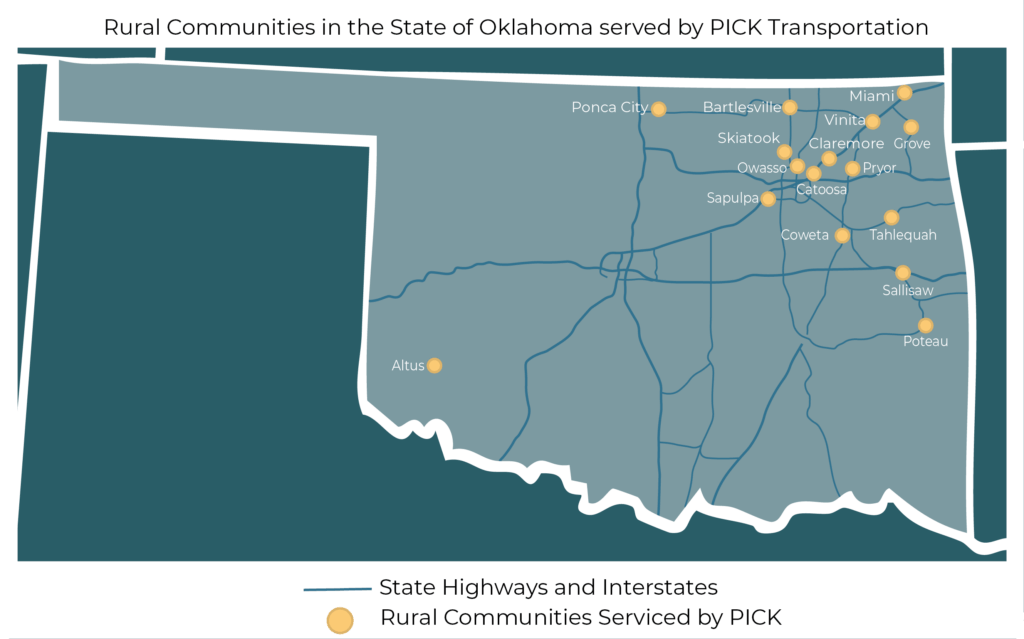
Rural Communities in the State of Oklahoma served by PICK Transportation. Credit: SUMC, with data from the PICK Transportation website
As of July 2025, PICK’s participant agencies provide service in 18 rural communities, covering a service area of more than 30,000 miles, and continue to build new partnerships to meet evolving transportation needs. The evolution of the PICK program highlights the value of innovative demonstration projects, as they offer a unique opportunity to test emerging technologies, develop meaningful partnerships, and pilot transportation solutions that directly respond to community needs. By adapting to meet various transportation needs, the service plays a vital role in connecting rural residents to essential services, enhancing the quality of life through reliable, after-hours mobility options.
Program Goals
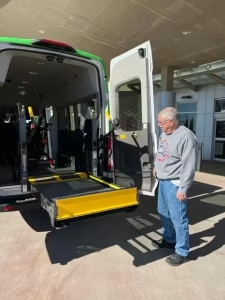
PICK Transportation driver Larry Wilson deploying an accessible ramp from the rear of a van. Credit: Mass Transit Magazine
The PICK program was conceived as a pilot program in response to rural rider survey feedback, which highlights the need for more flexible and on-demand transportation options and services that run later in the evening. In many rural areas with public transportation services, it is common that providers end service around 4:00 or 4:30 p.m., creating gaps in access for individuals needing to travel later in the day. PICK fills that gap by offering an on-demand travel option that allows riders to book trips spontaneously and within a matter of minutes. This technologically enabled service marks a major shift from traditional rural transit operations, which often relied on pen and paper scheduling or required riders to call transit agencies during business hours, often days in advance to book a trip.
The PICK program provides a fully ADA-compliant, on-demand transit service, ensuring everyone can use its services. The PICK service is enabled by on-demand technology that empowers riders to schedule and manage trips in real-time, providing greater flexibility and control. The project aims to deliver a seamless rider experience through a unified platform for ride booking and payment, while strengthening coordination among multiple transit providers, creating a more efficient, regionally connected system. Through this collaborative and multi-agency approach, the PICK consortium illustrates how rural transportation services can be delivered through a coordinated approach that simplifies the rider experience and helps to reduce service redundancy.
Partnerships
Partnerships are a core principle in the development of the PICK program. The program was created as a collaborative project that brought multiple transit agencies together. Partnerships have also been integral to its expansion. The PICK consortium began with 4 partner transit agencies: Pelivan Transit, JAMM Transit, Cimarron Public Transit System, and KATS. After the demonstration period, PICK faced a transition when one of the original partners in this project, JAMM Transit, stepped away from the consortium. Despite this loss of a partner, PICK’s participant agencies continued their focus on developing strategies that would help secure sustainable funding sources post-pilot phase to continue operating its services.
Since 2023, it has expanded to include several additional transit agency partners, as well as other types of partners, including hospitals, adult day centers, dialysis centers, and veterans’ centers. The PICK Consortium’s partners contribute at varying levels and take on different responsibilities. While transit agencies and operators pay a monthly cost for dispatching and technology services, others, such as rural hospitals, provide direct financial support to cover the cost of patient transportation. Service provided by PICK participant agencies primarily serves communities in eastern Oklahoma, but recently expanded to include a new community, the City of Altus, in the southwestern part of the state. This new service launched in June 2025, offering evening services in the City of Altus and at the Altus Air Force Base, making Altus the first community in western Oklahoma to join the program officially.
ODOT has been a vital partner in the development and expansion of the PICK services, providing critical financial support through cash matches for both the initial IMI grant and a subsequent Rural Surface Transportation grant. Beyond direct funding, ODOT’s support of the PICK program has been defined by a strong foundation of trust and shared commitment to innovation, as ODOT’s willingness to support new ideas, even those involving risk, has created an environment where PICK can adapt and grow on its own terms.
Besides building on partnerships with ODOT, local communities, Tribes, and transit agencies, PICK has also developed relationships with healthcare providers to help address gaps in rural healthcare transportation. PICK provides evening transportation services to and from dialysis centers and rural hospitals without requiring advanced booking. PICK’s collaboration with dialysis centers evolved organically as the program recognized that evening service could help reduce the need for early-morning appointments, which often required pickups as early as 3:00 a.m. By proactively engaging with dialysis centers, PICK helped extend clinic hours and improve patient access through a new transportation option tailored to their needs.
Similarly, the consortium has partnered with rural hospitals to provide rides for patients discharged in the evening, when traditional transportation options are unavailable. Previously, patients discharged after hours had limited choices and often resorted to costly ambulance rides to return home. The PICK services now offer a safe, reliable, and cost-effective alternative, providing patient transportation at no cost to the patient. Hospitals pay a flat rate of $3 per trip and reimburse PICK directly. This partnership relies on Via Transportation’s (Via) technology to facilitate a streamlined backend billing process. Via also provides key operational functions like routing, scheduling and dispatch, customer trip booking, data collection, and reporting.
Procurement of Technology
When the program first launched, the consortium selected Routematch as its technology provider for routing, dispatching, and booking. Shortly after, in 2020, Routematch was acquired by Uber, introducing opportunities and challenges for PICK participant agencies. While Uber’s customer-facing technology was sleek and efficient for riders, its backend system lacked key reporting functionalities that PICK participant agencies required, particularly for compliance with FTA’s Section 5311 Grant Program (Formula Grants for Rural Areas) and detailed National Transit Database reporting. Metrics such as vehicle revenue miles and hours, passenger miles traveled, unlinked passenger trips, and operating expenses had to be manually entered and compiled by staff, creating an inefficient and time-consuming process that strained staffing resources.
Following the conclusion of its IMI demonstration period, the PICK consortium initiated a formal Request for Proposals (RFP) process to identify a more suitable technology partner. PICK leadership approached the procurement process with an informed strategy shaped by its prior experience with Uber, underscoring the benefits of demonstration programs like the FTA’s IMI grant program. The demonstration period allowed the PICK consortium to test a technology-enabled mobility service and identify what aspects of the program work well or could be improved. For instance, rather than replacing one technology platform with another, the consortium prioritized finding a partner that could meet operational needs, provide a sufficient customer-facing and back-end platform, and support the agency’s overall vision for an innovative rural transit service. Via was selected for its focus on rural mobility, intuitive user interface, and collaborative approach to developing technology solutions that addressed the program’s needs. While its services were originally designed for a fixed-route system, Via worked closely with PICK participant agencies to adapt the platform to support on-demand transportation.
The integration of Via’s software into the program’s operations revealed a common challenge transit agencies face when implementing new technology: new technology can create anxiety among transit riders, drivers, and leadership. To address concerns among program stakeholders, even those closely involved in the process, PICK participant agencies focused on giving the transition time to take shape and carefully balancing the varied perspectives of those impacted to ensure a smooth transition. The PICK consortium also made it a priority to involve drivers early in the technology procurement process, recognizing that drivers interact with the platform every day. This collaborative approach helped foster a sense of ownership and motivated staff to actively engage with the new system once it was implemented. Strong leadership and clear guidance from the consortium played a key role in retaining staff and keeping operations stable through the growing pains of the transition.
During the demonstration phase, PICK’s project managers’ ability to understand ridership was limited by the limited data provided by Uber, including overall ridership levels and general travel patterns, and datasets that did not always meet the formatting needs of the agency. In procuring a new technology vendor, the GGEDA leveraged this lesson learned to ensure PICK participant agencies have a greater ability to collect more comprehensive data, which has had a significant impact in transforming operations and enabling growth. Via’s platform customizable design allows the consortium to collect data on detailed trip purposes, including the expected categories of shopping, recreation, and employment, but also other vital needs such as childcare, after-hours dialysis center trips, and hospital discharges. This data has been an especially valuable tool to support expanding partnerships with rural hospitals by facilitating direct billing for patient discharge trips.
Additionally, the data collected through Via’s system helps enhance the rider experience and clearly demonstrates the value of PICK services to stakeholders. Detailed information on trip purposes can be used to support local and community grant applications and can highlight the economic impact of transportation services, particularly to key destinations like Walmart, places of employment, and other businesses. With this data, the consortium is better equipped to showcase its value to the community and plans to use these insights to demonstrate its impact on specific businesses and destinations when seeking grant funding or local support.
To demonstrate the value of accelerating mobility innovation in rural areas, it is worth reflecting on the fact that several of the PICK participant agencies previously utilized minimal or no technology in their transportation operations, relying instead on manual methods like pen and paper for their trip requests, scheduling and dispatching tasks. Transitioning to an on-demand model and technology was a major shift for many of these agencies and presented a steep learning curve. These agencies have displayed adaptability and resilience in learning and adopting new technologies to support their participation in the PICK program. Rural agencies have been with the PICK consortium from the beginning, evolved alongside new technology platforms, and overcame challenges together. After navigating the complexities of switching technology vendors, PICK participant agencies are seeing benefits from the program’s iterations and its focus on innovation to continue to strengthen the program.
Funding
In 2020, GGEDA secured a $1.5 million IMI grant from the FTA to fund the development and launch of the PICK program. The FTA’s IMI program promotes innovative, technology-driven solutions and requires a local match of at least 20%. To meet the local match requirement, PICK partnered with ODOT, which provided a substantial financial contribution. This support was pivotal in deploying the service ground and sustaining its operations through the demonstration period.
Given the popularity of the service, the consortium began developing strategies to secure long-term funding and ensure the program’s sustainability beyond the life of the IMI grant. PICK participant agencies primarily provide service through operational funding supported through the FTA’s Section 5311 Program, Formula Grants for Rural Areas, and is supplemented by a range of other funding mechanisms. These include contributions from partners for technology and dispatching, community matches in service areas, hospital-subsidized trips, and various grant awards. ODOT has worked closely with PICK participant agencies to align operational structures with FTA eligibility requirements of Section 5311 funding, ensuring that elements such as technology infrastructure and call center staffing qualify for reimbursement. This collaboration between GGEDA and ODOT was critical, as eligibility for Section 5311 funding is essential to the long-term sustainability and scalability of the program. By aligning operations with federal funding requirements, this partnership laid the groundwork for continued service delivery and future growth.
Each partner agency that is a part of the PICK consortium contributes financially to help cover the operational expenses associated with the technology, including licensing, dispatching services, and call center support. This pooled resources model helps spread costs across partners and allows PICK participant agencies to operate without placing too much burden on any single provider.
Another funding mechanism supporting the sustainability of the consortium is the use of community match contributions from participating service areas. As PICK agencies expand service into new communities, these local contributions increase proportionally, reflecting each area’s share of service coverage. This funding aspect helps ensure financial responsibilities are distributed evenly across the consortium and fosters a sense of shared responsibility among local partners.
GGEDA’s ability to successfully secure grants has been critical to the PICK program’s continued operations and expansion. Post-IMI grant, a USDOT’s Rural Surface Transportation grant, awarded to GGEDA in 2023 to further expand the consortium’s partnerships and service area, enabled PICK’s permanent service. ODOT once again offered critical financial support to fill the local match for this grant, which allowed the PICK consortium to onboard four new rural transit agency partners: First Capital Trolley, Lift Community Action Agency, Southern Oklahoma Rural Transit Agency, and Southwest Community Action Group.
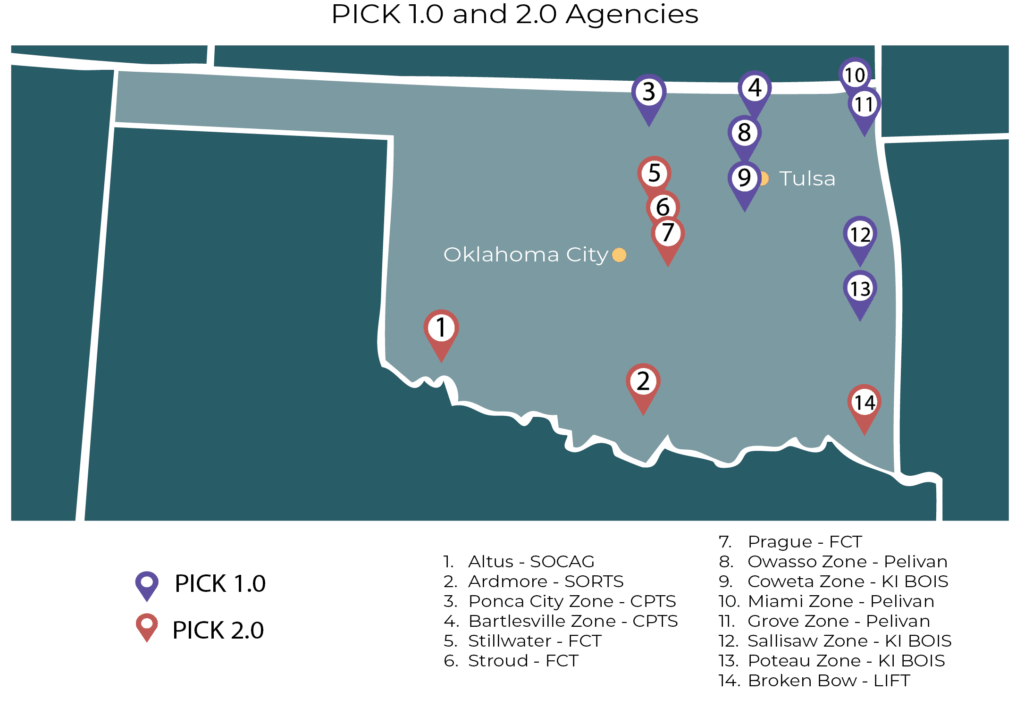
PICK 1.0 and 2.0 Service Areas. Credit: SUMC, with data from USDOT, Rural Surface Transportation Program – 2023 & 2024 Award Fact Sheets
A key innovation in the PICK program’s funding model is partnerships with rural hospitals, which contract directly with the consortium to arrange and fund patient transportation. An after-hours ride costs $3 fare and is billed directly to the hospital rather than the patient. This removes financial barriers for patients while providing hospitals with a reliable and affordable mobility option. The direct billing structure only became feasible after the consortium procured Via as a new technology vendor, which enabled seamless backend billing, including direct billing capabilities.
Funding for operations continues to be a concern. As the PICK program continues to grow, managing the increasing number of partners becomes more complex. Pelivan Transit, as the lead agency within the PICK consortium, is responsible for distributing monthly invoices and tracking payments through the system. Each partner in the consortium is invoiced separately, which requires a constant effort from Pelivan Transit to issue monthly bills and follow up on timely processing and payment. Coordinating billing and ensuring that each partner meets its financial obligations for dispatching and technology costs has proven to be an ongoing administrative challenge.
Ongoing Challenges
Since its development and launch during the COVID-19 pandemic, with shelter-in-place orders and reduced ridership, PICK participant agencies have faced several challenges, including driver and staffing shortages. While these issues persist on some level, the consortium has implemented strategies such as flexible schedules and split shifts to make driving roles more appealing to job seekers and retain existing drivers.
The PICK consortium continues to navigate the complexities of managing a broad network of partners. Working to ensure accountability from partners, bringing in new collaborators, and keeping operations aligned across various agencies requires ongoing effort and communication.
The program also faced difficulties meeting reporting requirements for rural funding programs due to limitations in the backend technology provided by its original vendor. These issues prompted a procurement process to identify a more suitable technology partner. Technology management remains a continuous effort, as the consortium works to stay current with rapidly evolving tools and platforms in partnership with Via.
Funding remains an ongoing area of focus for the program, as it relies heavily on external support. PICK participant agencies advocate for sustainable funding streams and actively seek new opportunities for partnerships and grants. These efforts are crucial to support the operations and expansion of the program.
Impacts
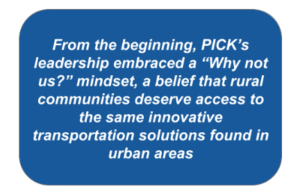
From the beginning, PICK’s leadership embraced a “Why not us?” mindset, a belief that rural communities deserve access to the same innovative transportation solutions found in urban areas. This proactive approach challenges the notion that small towns and Tribal areas can’t adopt or operate innovative transportation services, such as mobility on-demand, simply because those services and the technologies that support them are uncommon in rural settings. Rather than accept those limitations, the mobility innovators who developed PICK leaned into the opportunity to lead.
The PICK consortium’s “Why not us” approach reimagined what rural transit could look like with the adoption of new technology. PICK’s participant agencies deployed an app-based on-demand service powered by real-time scheduling, dynamic dispatching, and direct communication with riders, providing a spontaneous transportation option. But the team supporting the program also understood the realities of operating in rural and Tribal communities where broadband is often unreliable and smartphone access and technology literacy may be limited. With this in mind, the PICK program was designed with an inclusive system ensuring riders could also book trips through a live call center operated by Pelivan Transit. This multipronged approach for riders to book trips ensured that new technology increased access to transportation options rather than limited it. The consortium’s strategy reflects a commitment to finding solutions that directly address local challenges, driven by dedication and the courage to take initiative.
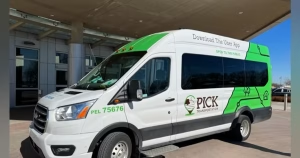
A PICK Transportation Vehicle. Credit: Mass Transit Magazine
After transitioning to Via’s technology, Pick’s service experienced a significant increase in ridership. In 2025, the program saw a 24% overall ridership increase, with Pelivan Transit’s ridership alone contributing to 51% of that total during PICK’s operational hours. Via’s technology allows the consortium to analyze ridership trends in more detail, helping to better understand the impact of its services, including trips made for childcare. Access to reliable transportation for childcare purposes supports families in multiple meaningful ways. For example, it helps parents maintain employment, attend essential appointments, and ensures that children can reach childcare facilities safely and on time. Without the support of adequate mobility options, many parents face long commutes, reduced work hours, or may be forced to leave the workforce entirely. By providing reliable on-demand mobility, the program supports childcare connections and plays a vital role in supporting economic participation and family stability.
The PICK consortium has observed a consistent demand for trips servicing critical healthcare needs, including transportation to and from evening dialysis appointments and late-night hospital discharge patients. These use cases weren’t a part of the original design but emerged naturally, highlighting deeper unmet transportation needs in the region. For dialysis patients, PICK offers a reliable, flexible, and cost-effective way to access essential treatments often scheduled outside typical transit hours, therefore removing a major barrier to care. Reliable transit ensures patients can avoid missed or shortened appointments, which can substantially increase their risk of hospitalization and mortality. Likewise, for patients discharged from hospitals at night, PICK provides an affordable way to get home, helping to prevent unnecessary overnight admissions or costs of private transportation. PICK’s efforts to close these gaps support improving health outcomes and reducing strain on rural and Tribal families and healthcare systems by enabling timely transitions from hospital to home.
PICK’s innovative service has made broad impacts beyond its partner agencies and riders. Some transit agencies in Tribal areas not part of the PICK consortium have begun offering their own after-hours service, drawing inspiration from the PICK 2.0 RFP. Agencies have modeled their own procurement process after PICK 2.0 to acquire the technology needed to support on-demand mobility. Key sections of the RFP, such as those focused on fostering strategic partnerships, encouraging scalable innovation, and vendor transparency, have been particularly influential. These agencies were able to adopt the PICK model while still upholding their individual branding.
Future Plans
GGEDA plans to continue operating and expanding the PICK program to serve the varied transportation needs of the region. As of July 2025, PICK’s leadership was preparing to bring in two additional transit agencies, with several more interested agencies in the pipeline. These efforts aim to help the service reach more people and further expand its area coverage. In addition, PICK’s leadership is exploring strategies to engage industrial parks in discussions about the transportation needs for shift workers, particularly to close the current service gap around the 11:00 pm release time. While the consortium currently operates in Oklahoma, the agency has the ability to cross state lines, creating the potential opportunity for future expansion beyond state limits. The PICK consortium is also exploring the addition of a Mobility Manager to assist in operations for both PICK and GGEDA.
Conclusion
The idea of the PICK program stemmed from the direct feedback of rural transit riders who commonly shared that they wanted more spontaneous, evening transportation that extended beyond typical operating hours. This shared insight sparked the idea to create a new, regional on-demand transportation program, which eventually evolved into PICK Transportation. At the core of the program’s development is the principle that understanding the problem fully must come before moving to solutions. This approach reflects Principle 1 of SUMC’s Mobility Innovation Guidebook, which encourages project planners to start by defining end users’ needs, wants, and pain points before brainstorming or developing a pilot project. By focusing on one issue and addressing it through collaboration, programs like PICK can develop more effective solutions rather than applying fixes without addressing core challenges.
Strategic partnership building has been a foundational aspect of the PICK service model. The structure of the PICK program was designed as a collaborative initiative from the beginning, bringing together four core providers. The consortium’s shared vision focused on creating a better life for its riders by providing after-hours transportation options. Since its pilot phases, PICK’s leadership has expanded its number of partners, and the consortium has become more resilient despite obstacles such as the impacts of COVID-19 and the transition to a different technology vendor. Collaboration with key partners, such as FTA, ODOT, and Via, continues to drive the program’s financial sustainability and growth. These partnerships align with Principle 4 of SUMC’s Mobility Innovation Guidebook, which focuses on fostering partnerships to pursue and sustain new mobility projects. The PICK consortium also demonstrates Principle 7, which highlights the value of leveraging existing resources effectively. Since all partners contribute financially, the consortium can pool resources, expand service areas, and create a greater collective impact across the region.
The PICK program’s transition from a pilot project to a permanent mobility option depended on securing sustainable funding beyond the IMI grant. Its success in obtaining this funding is closely tied to the partnerships the consortium built during the pilot phase and the impact of its services. The PICK program’s partnership with ODOT was especially pivotal, as ODOT provided funds to support cash matches for multiple grants and worked collaboratively with PICK participant agencies to structure its services to qualify for FTA Section 5311 funding. As the consortium continues to grow and add new partners, its financial sustainability is partially supported by partner contributions that help fund the agency’s technology and dispatching services.
Mobility-on-demand transportation solutions, such as the PICK Transportation program, have the opportunity to fill travel gaps and promote mobility as a right. By leveraging technology, building partnerships, and securing sustainable funding, the PICK consortium was able to bring and expand affordable, on-demand transportation to Tribal nations and other communities in rural Oklahoma.